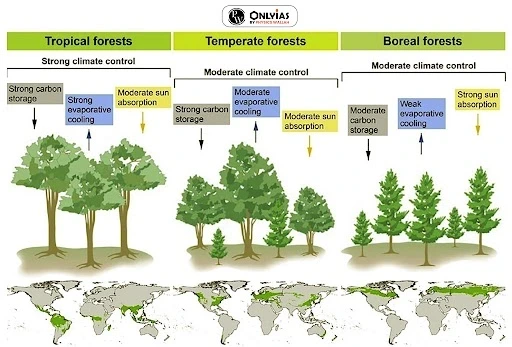| Forest Ecosystem: Biodiversity, Types, & Crucial Roles in Environmental Balance |
Forest Ecosystem: Biodiversity and Harmony
A forest ecosystem is a complex and interconnected community of plants, animals, microorganisms, and their physical environment within a forested area. They provide habitats for countless organisms, from tiny insects to large mammals, and support a diverse range of flora.
Forest Ecosystem Overview: The Essence of Forest Diversity
- A forest is a large and complex ecosystem characterized by a dense collection of trees, shrubs, plants, and various organisms within a particular geographic area.
- Forests can vary widely in terms of tree species, climate, and ecological conditions.
Types of Forest: Exploring Diverse Forest Ecosystem
Forest ecosystems are of three types:
- Coniferous /Taiga/Boreal Forest
- Temperate Forest
- Tropical Rainforest

1. Coniferous forest/Taiga/Boreal Forest: A Unique Forest Ecosystem
- About: This forest ecosystem is sandwiched between the tundra to the north and the temperate forest to the south.
- Distribution: It stretches in a great continuous belt across North America, Europe and Asia.
- Almost absent in the southern hemisphere because of the narrowness of the southern continents in the high latitudes.
- Abiotic components: Well defined seasons: a lengthy, bitterly cold winter and a brief, mild summer.
- The existence of local winds, such as the buran of Eurasia and blizzards of Canada.
- Precipitation: Evenly distributed precipitation throughout the year. It ranges from 200 to 600 mm per year.
- Soil type: Podzolized soil (acidic, excessively leached and mineral deficient)
- Biotic components:
- Flora: Consists mostly of conifers evergreen; conical in shape; thick, leathery and needle-shaped leaves. E.g.: Pine, Fir, Spruce, Larch
- Fauna: Mink, Silver fox, Lynx, Wolf.
2. Temperate Forest: Exploring the Temperate Forest Ecosystem
- About: It is distinguished by broad-leaved trees that produce new foliage in the autumn and shed their leaves in the autumn.
- Further division: it can be further divided into –Temperate Deciduous (mainly in the northern hemisphere), Temperate Evergreen (found in Mediterranean climatic region) and Temperate Rainforest (found in both the hemispheres and coastal regions).
- Distribution:
- Found in the mid-latitudes, between the tropics (grade into Tropical rainforest) and the polar regions (which transition into the boreal forest).
- Found in both the northern and southern hemisphere.
- Abiotic components:
- Climate: Presence of distinct seasons. Moisture-filled, warm summer and frosty or wet winter.
- Soil type: Alfisol or brown forest soil (under temperate broadleaved deciduous forests.)
- Biotic components:
- Flora: Broadleaf trees (oaks, maples, beeches), shrubs, perennial herbs, and mosses.
- Fauna: Squirrels, marsupials, brown bears, bats, rodents.
3. Tropical Rainforest: Lush Green Ecosystem
- About: It is described as the most lush green forest with a wide variety of communities and constitutes one of the biggest biomes on the planet.
- Distribution:
-
- Found in wet tropical uplands and lowlands around the Equator.
- Abiotic components:
- Humidity: High humidity and temperature (more or less uniform)
- Precipitation: Exceeds 200cm, evenly distributed throughout the year
- Soil type: Red latosol (high rate of leaching makes it agriculturally useless). But it can rejuvenate with nutrients when left undisturbed.
- Biotic Components:
- Flora: A wide range of angiosperms and a dearth of gymnosperms.
- Algae, liverworts, creepers, ferns, mosses, and lichens are also present.
- There is presence of both a dense upper canopy and a thick undergrowth.
- Fauna: Monkeys, rhinos, large numbers of insects, birds.
- Distinctive Features: These forests’ vegetation exhibits a layered structure.
-
- Each Layer has distinct features depending on varying levels of water, sunshine, and air movement.
- Four-Layered Structure: Tropical forest’s vegetation exhibits a four-layered structure which are as Emergent Layer, Canopy Layer, Understory Layer and Forest Floor layer.
Why is the soil of tropical rainforests poor and infertile?
|
Forest Ecosystem: Guardians of Biodiversity and Environmental Balance
- Forest ecosystems are intricate and invaluable components of our planet’s natural heritage.
- They provide essential ecosystem services, such as carbon sequestration, climate regulation, and water purification, while also supporting biodiversity and human well-being.
|
Previous Year Questions (Prelims) Q. If a tropical rainforest is removed, it does not regenerate quickly as compared to a tropical deciduous forest. This is because_________________(2011)
Answer (A) Q. Consider the following statements: (2011)
Which of the statements given above is/are correct?
Answer (C) |






























